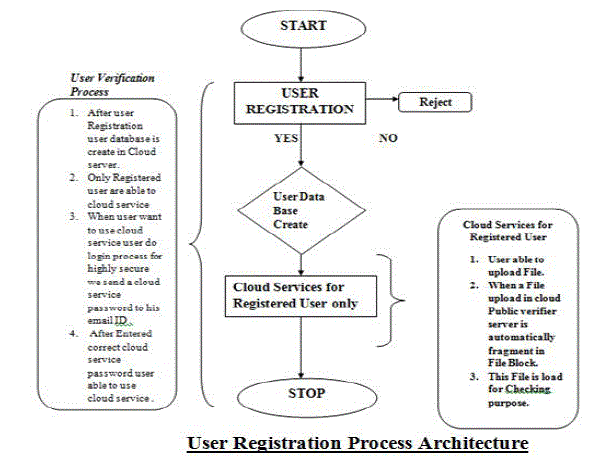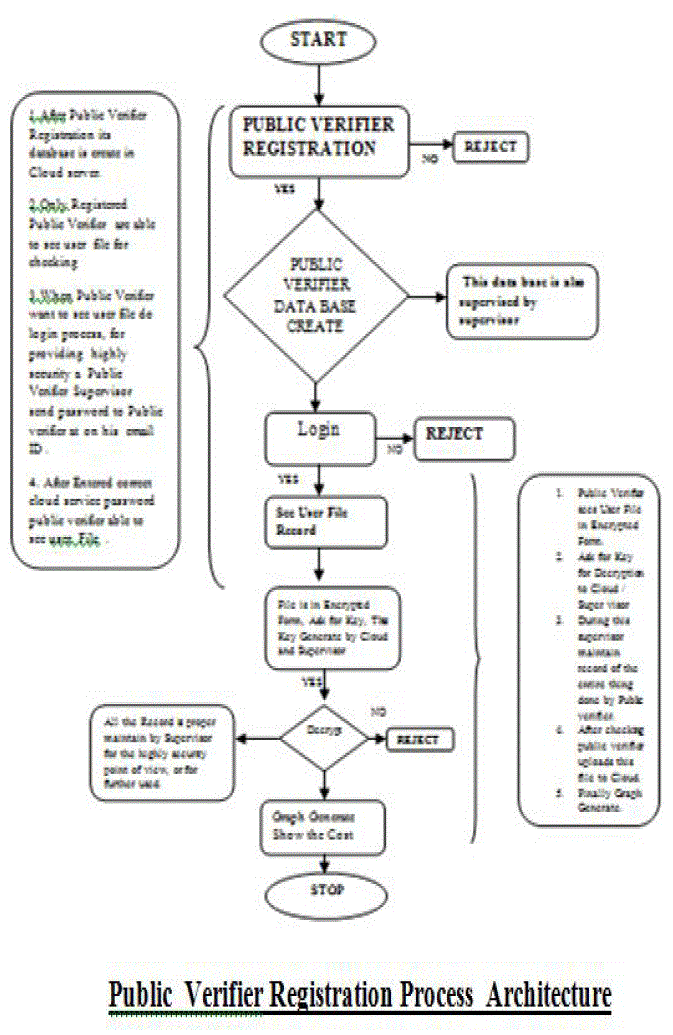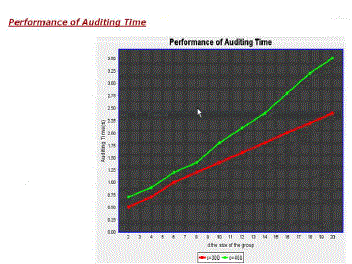Keywords
|
| Cloud computing , Public Cloud ,Private Cloud , Hybrid Cloud ,Third party auditing . |
INTRODUCTION
|
| In the cloud storage Environment , users can remotely save their content and used software application already available in cloud server when they needed, user also able to shared his her data or information to other user cloud user use resources of cloud without the burden of local data storage and maintenance. However, the fact that users no longer have physical possession of the outsourced data makes the data integrity protection in cloud computing a formidable task, especially for users with constrained computing resources. To securely introduce an effective TPA, the auditing process should bring in no new vulnerabilities toward user data privacy, and introduce no additional online burden to user. This introductory section of cloud is some keyword of cloud computing .Nowadays cloud computing is a hot topic all over the world, through which customers can access information, software , resources without a arranging a basic requirement with the help of web browser or internet . Hence, it eliminates the need for maintaining expensive computing facilities. On the other hand a brief introduction about the cloud computing . A Cloud computing is an attractive and cost efficient continuation of server based computing [Ref -1] and application service provider model brief information about the cloud model explain Next Paragraph .We see cloud computing as a highly available computing environment where secure services and data are delivered on-demand pattern. There are so many definitions of Cloud computing .As per the National Institute of Standards and Technology (N IST) [Ref-2], says a cloud computing is “A model for enabling convenient, on-demand network access to a shared pool of configurable computing resources. In this category we include Resources like Servers, Networks, Storage, and some Services that can be rapidly provisioned and released with minimal management effort or service provider interaction”. |
| Cloud [Ref-3] computing model are Public Cloud computing Model and Private Cloud Computing Model and Hybrid Cloud Computing Model |
1.1 Public Cloud Computing
|
| Public Cloud computing means relying on third parties to offer efficient IT services over the Internet as needed. Public Clouds are owned by the organization(s) selling Cloud services, The National Institute of Standards and Technology defines a public Cloud as a Cloud infrastructure that is made available to the general public or a large industry group |
1.2 Private Cloud Computing
|
| Private Cloud computing reassures the organization that their information and processes are more secure since everything is managed internally. According to the National Institute of Standards and Technology (NIST) a private Cloud is a Cloud infrastructure that is operated solely for an organization |
1.3 Hybrid Cloud Computing Model
|
| Hybrid Cloud computing is a combination of both private and public services |
1.4 Cloud Computing Services
|
| Infrastructure as a service (IaaS). Computing infrastructure, such as servers, storage, and network, delivered as a cloud service, typically through virtualization. Platform as a service (PaaS). Platforms that can be used to develop and deploy applications. Software as a service (SaaS). Software deployed as a hosted service and accessed over the Internet. |
1.5 Public Verifier
|
| Public verifier is able to verify the integrity of shared data without retrieving the entire data while the identity of the signer on each block in shared data is kept private from the public verifier. |
1.6 Public auditing
|
| Existing system allow not only a data owner itself but also a public verifier to efficiently perform integrity checking without downloading the entire data from the cloud, which is referred to as public auditing |
| Data is divided into many small blocks, where each block is independently signed by the owner; and a random combination of all the blocks instead of the whole data is retrieved during integrity checking. |
| A public verifier could be a data user who would like to utilize the owner’s data via the cloud or a third-party auditor (TPA) who can provide expert integrity checking services |
1.7 Privacy in public auditing
|
| During public auditing on cloud data, the content of private data belonging to a personal user is not disclosed to any public verifiers. Unfortunately, current public auditing solutions mentioned above only focus on personal data in the cloud |
1.8 Privacy to public verifiers
|
| Sharing data among multiple users is perhaps one of the most engaging features that motivate cloud storage. It is necessary to ensure the integrity of shared data in the cloud is correct. Existing public auditing mechanisms can actually be extended to verify shared data integrity. |
| This is Brief introduction of Cloud computing Environment , Rest of paper is organized as follows . In Section number Two , we briefly discuss related work Literature Review . Then we present the Problem definition in section number Three In section number Four we introduce a proposed new cloud architecture for Third party auditor authentication . In Section number five we are show the Audit graph and Performance Result . In Section number Six include a conclusion end of the paper show References used . |
II. LITERATURE SURVEY
|
| A careful analysis of literature on the variants and methodologies of privacy preserving in cloud computing reveals the following: So many method are already exiting for auditing cloud content before storing cloud Environment , this will be done Third person or some time called TPA .The user might give his/her identity of proof certificate [Ref- 3] This paper includes the problems of misuse of the proof of identity (POI) certificate if fallen into unauthorized person. However, public auditing on the integrity of shared data with these existing mechanisms will inevitably reveal confidential information-identity privacy-to public verifiers. Bharathy S et al. decentralized key management work for providing a security to cloud data [Ref-4] Security and privacy protection in clouds are being explored by many researchers. Wang et al. [Ref- 6] addressed storage security using Reed-Solomon erasure-correcting codes. Authentication of users using public key cryptographic techniques has been studied in [Ref- 7]. Many homomorphic encryption techniques have been suggested [Ref- 8], [Ref- 9] to ensure that the cloud is not able to read the data while performing computations on them. HLA homorphic liner authenticaot [Ref-10] scheme is used by TPA to perform the auditing task in cloud , this work done in without demanding a local copy of data ,Access control in clouds is gaining attention because it is important that only authorized users have access to valid service. A huge amount of information is being stored in the cloud, and much of this is sensitive information. Care should be taken to ensure access control of this sensitive information which can often be related to health, important documents (as in Google Docs or Drop box) or even personal information (as in social networking) |
III. PROBLEM DEFINITION
|
| |
| In we are show the simple working concept of Auditing task where data will be shared after completion auditing task , this task is done by public verifier / auditor. So during literature survey I am read so many method describe for solving this problem . data will be audit by public verifier now here we just assume that a public verifier is doing his work honestly , solving this problem I have introduce a new cloud data public verifier architecture that supervise a working of third part public auditor . |
IV. PROPOSED ARCHITECTURE
|
V. RESULT
|
| Our experimental results demonstrate the effectiveness and efficiency of our mechanism when auditing shared data integrity and we show the improve result via auditing graph shown in this paper |
| Graph is Generated during complication of all work of User and Public verifier . |
VI. CONCLUSION
|
| We have used the new architecture for providing a high security with proper manage of Third party auditor database in cloud this record will be mange by Public auditor Supervisor . this all the record is very help full for further utilization if any deficiency is occur , one more thing all the Third party working is supervised by public auditor supervisor this is provide a more security . we also make a improved graph for all work done by public verifier . |
Figures at a glance
|
 |
 |
 |
| Figure 1 |
Figure 2 |
Figure 3 |
|
| |
References
|
- 91-US-31-1_Cloud_Computing White Paper Cloud Computing: Thin clients in the clouds. (2009)
- The NIST Definition of Cloud Computing. Retrieved March 15, 2012 from http://www.nist.gov/itl/cloud/upload/cloud def-v15.pdf
- Buecker. A., Lodewijkx. K., Moss.H.,Skapinetz. K.,&Waidner. M. (2009).Cloud Security Guidance.IBM Recommendations for theImplementation of Cloud Security. Cloud security: the grand challenge. Retrieved April 16, 2012 from http://www.redbooks.ibm.com/redpapers/pd fs/redp4614.pdf
- Bertino, E.; Paci, F.; Ferrini, R.2009 Privacy-preserving Digital Identity Management for Cloud Computing, IEEE Computer Society Technical Committee on Data Engineering.
- Divyabharathy S, Ramesh T 2014 IEEE International Conference on Innovations in Engineering and Technology (ICIET’14) On 21st& 22nd March Organized by K.L.N. College of Engineering, Madurai, Tamil Nadu, India International Journal of Innovative Research International Journal of Innovative Research in Science, Engineering and Technology Volume 3, Special Issue 3, March 2014ISSN (Online) : 2319 – 8753 ISSN (Print) :2347 – 6710
- C. Wang, Q. Wang, K. Ren, N. Cao and W. Lou, “Toward Secure and Dependable Storage Services in Cloud Computing”, IEEE T. ServicesComputing, vol. 5, no. 2, pp. 220–232, 2012.
- H. Li, Y. Dai, L. Tian, and H. Yang,“Identity-based authentication for cloud computing,” in Cloud Com, ser. Lecture Notes in ComputerScience, vol. 5931.Springer, pp. 157–166, 2009.
- C. Gentry, “A fully homomorphic encryption scheme,” Ph.D. Dissertation, Stanford University, 2009. http://www.crypto.stanford.edu/craig.
- A.-R. Sadeghi, T. Schneider, and M. Winandy, “Token -based cloud computing,” in TRUST, ser. Lecture Notes in Computer Science, vol.6101. Springer,pp. 417–429, 2010.
- Privacy-Preserving Public Auditing for Secure Cloud Storage IEEE 2013 Transaction, Computers, Feb 2013
- Decentralized Access Control with Anonymous Authentication of Data Stored in Clouds SushmitaRuj‡,
- H. K. Maji, M. Prabhakaran, and M. Rosulek, “Attribute-based signatures:Achieving attribute-privacy and collusion resistance,”IACRCryptology e Print Archive, 2008.
- F. Zhao, T. Nishide, and K. Sakurai, “Realizing fine-grained and flexible access control to outsourced data with attribute-basedcryptosystems,” in ISPEC, ser. Lecture Notes in Computer Science, vol. 6672. Springer, pp. 83–97, 2011 [Ref-14] Kan Yang, XiaohuaJia and Kui Ren, “ DAC-MACS: Effective Data Access Control for Multi-Authority Cloud Storage Systems”, IACR Cryptology ePrint Archive, 419,2012
- S. Ruj, A. Nayak, and I. Stojmenovic, “DACC: Distributed access control in clouds,” in IEEE TrustCom, 2011.
|